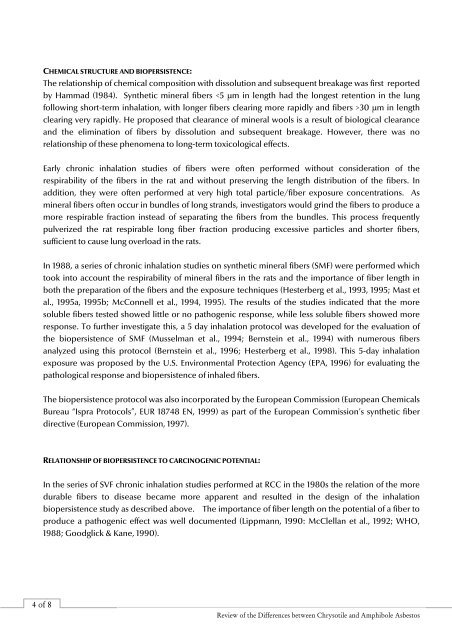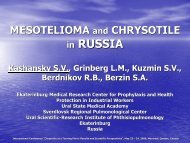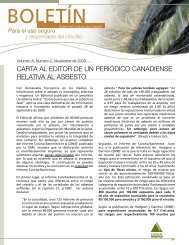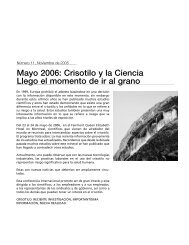Review of the Differences between Chrysotile and Amphibole
Review of the Differences between Chrysotile and Amphibole
Review of the Differences between Chrysotile and Amphibole
You also want an ePaper? Increase the reach of your titles
YUMPU automatically turns print PDFs into web optimized ePapers that Google loves.
CHEMICAL STRUCTURE AND BIOPERSISTENCE:The relationship <strong>of</strong> chemical composition with dissolution <strong>and</strong> subsequent breakage was first reportedby Hammad (1984). Syn<strong>the</strong>tic mineral fibers 30 μm in lengthclearing very rapidly. He proposed that clearance <strong>of</strong> mineral wools is a result <strong>of</strong> biological clearance<strong>and</strong> <strong>the</strong> elimination <strong>of</strong> fibers by dissolution <strong>and</strong> subsequent breakage. However, <strong>the</strong>re was norelationship <strong>of</strong> <strong>the</strong>se phenomena to long-term toxicological effects.Early chronic inhalation studies <strong>of</strong> fibers were <strong>of</strong>ten performed without consideration <strong>of</strong> <strong>the</strong>respirability <strong>of</strong> <strong>the</strong> fibers in <strong>the</strong> rat <strong>and</strong> without preserving <strong>the</strong> length distribution <strong>of</strong> <strong>the</strong> fibers. Inaddition, <strong>the</strong>y were <strong>of</strong>ten performed at very high total particle/fiber exposure concentrations. Asmineral fibers <strong>of</strong>ten occur in bundles <strong>of</strong> long str<strong>and</strong>s, investigators would grind <strong>the</strong> fibers to produce amore respirable fraction instead <strong>of</strong> separating <strong>the</strong> fibers from <strong>the</strong> bundles. This process frequentlypulverized <strong>the</strong> rat respirable long fiber fraction producing excessive particles <strong>and</strong> shorter fibers,sufficient to cause lung overload in <strong>the</strong> rats.In 1988, a series <strong>of</strong> chronic inhalation studies on syn<strong>the</strong>tic mineral fibers (SMF) were performed whichtook into account <strong>the</strong> respirability <strong>of</strong> mineral fibers in <strong>the</strong> rats <strong>and</strong> <strong>the</strong> importance <strong>of</strong> fiber length inboth <strong>the</strong> preparation <strong>of</strong> <strong>the</strong> fibers <strong>and</strong> <strong>the</strong> exposure techniques (Hesterberg et al., 1993, 1995; Mast etal., 1995a, 1995b; McConnell et al., 1994, 1995). The results <strong>of</strong> <strong>the</strong> studies indicated that <strong>the</strong> moresoluble fibers tested showed little or no pathogenic response, while less soluble fibers showed moreresponse. To fur<strong>the</strong>r investigate this, a 5 day inhalation protocol was developed for <strong>the</strong> evaluation <strong>of</strong><strong>the</strong> biopersistence <strong>of</strong> SMF (Musselman et al., 1994; Bernstein et al., 1994) with numerous fibersanalyzed using this protocol (Bernstein et al., 1996; Hesterberg et al., 1998). This 5-day inhalationexposure was proposed by <strong>the</strong> U.S. Environmental Protection Agency (EPA, 1996) for evaluating <strong>the</strong>pathological response <strong>and</strong> biopersistence <strong>of</strong> inhaled fibers.The biopersistence protocol was also incorporated by <strong>the</strong> European Commission (European ChemicalsBureau “Ispra Protocols”, EUR 18748 EN, 1999) as part <strong>of</strong> <strong>the</strong> European Commission’s syn<strong>the</strong>tic fiberdirective (European Commission, 1997).RELATIONSHIP OF BIOPERSISTENCE TO CARCINOGENIC POTENTIAL:In <strong>the</strong> series <strong>of</strong> SVF chronic inhalation studies performed at RCC in <strong>the</strong> 1980s <strong>the</strong> relation <strong>of</strong> <strong>the</strong> moredurable fibers to disease became more apparent <strong>and</strong> resulted in <strong>the</strong> design <strong>of</strong> <strong>the</strong> inhalationbiopersistence study as described above. The importance <strong>of</strong> fiber length on <strong>the</strong> potential <strong>of</strong> a fiber toproduce a pathogenic effect was well documented (Lippmann, 1990: McClellan et al., 1992; WHO,1988; Goodglick & Kane, 1990).4 <strong>of</strong> 8<strong>Review</strong> <strong>of</strong> <strong>the</strong> <strong>Differences</strong> <strong>between</strong> <strong>Chrysotile</strong> <strong>and</strong> <strong>Amphibole</strong> Asbestos







